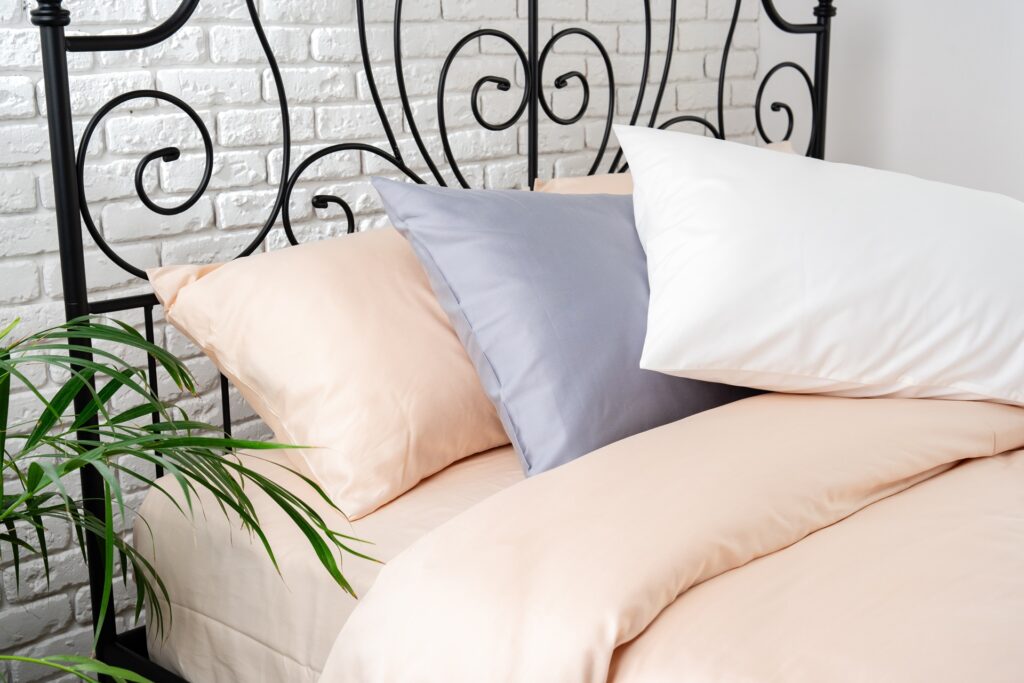Keeping your comforter fresh and clean is a big part of what makes your bed the best place to unwind after a long day. As for its fluffiness, that’s what adds that extra layer of comfort—the kind that makes you want to never leave.
The challenge, though, is keeping that fluffiness intact after multiple washes. Many comforters (and even weighted blankets) easily go from plush and cozy to flat and lifeless if you don’t clean them the proper way. So yes, there’s a “proper way” to care for your comforter—one that preserves its softness, protects its filling, and ensures it stays luxurious no matter how frequently you use it.
Keep reading to learn the expert-approved tips to keep your comforter fluffy and fresh, even after countless cycles through the wash.
How Often Should Comforters Be Washed?
We mainly wash our comforters for hygiene and sanitation. But if every time you notice a stain or smell a faint foul odor you instantly load it into your washer, expect the fabric to flatten and the filling to compress.
Here’s a guide to help you decide the frequency of washing your comforters:
- Every 3–4 Months for Regular Use. If you use a duvet cover and don’t have pets or allergies, washing your comforter once every season is enough to keep it clean without unnecessary wear.
- Every 1–2 Months if You Have Pets. Pets often shed hair and bring dirt or dander into your bedding, which means your comforter needs more frequent cleaning to stay fresh and hygienic.
- Monthly if You Suffer from Allergies. For allergy sufferers, dust mites, pollen, and bacteria can build up quickly, so washing your comforter once a month helps keep these irritants at bay.
- After Any Spills or Stains. Spills from coffee, wine, or food should be addressed immediately to prevent stains from setting or odors from lingering.
- Before Seasonal Storage. If you’re storing your comforter for the summer, wash it before putting it away to prevent dirt, sweat, or skin oils from causing odors or attracting pests.
- Annually for Rarely Used Comforters. If a comforter is more decorative or stored as a backup, an annual wash is sufficient to keep it fresh and ready for occasional use.
- Every 2–3 Weeks for Bare Comforters. If you skip the duvet cover and sleep directly under the comforter, you need to wash it more frequently—every two to three weeks—to maintain hygiene.
- As Needed for Odors or Visible Dirt. Even if it’s not time for a routine wash, promptly address any noticeable smells or visible dirt to keep your bedding inviting and comfortable.
By sticking to these guidelines, you can strike the perfect balance between keeping your comforter fresh and preserving its fluff for years to come.
How to Maintain the Fluffiness of Comforters According to its Material

Comforters are made of all kinds of materials—each with its’ unique texture, feel, and level of care needed to keep it in tip-top shape. A down comforter, for example, needs a gentler touch than a synthetic microfiber, while weighted blankets call for extra attention to their filling.
Let’s break down the best care practices for the most common comforter types.
1. Down Comforters
Down comforters are filled with soft feathers that provide incredible insulation and a luxurious, cloud-like feel. However, these feathers can clump or flatten if not cared for properly.
Care Tips:
- Washing: Always check the care label, but most down comforters can be machine washed on a delicate cycle using a mild detergent. Avoid bleach or harsh cleaners, as they strip the feathers of their natural oils.
- Drying: Dry your down comforter on low heat in a large clothes dryer. Toss in a few clean tennis balls or dryer balls to help redistribute the feathers and prevent clumping.
- Storage: Store it in a breathable cotton bag or linen closet during off season. Avoid plastic bags, as they can trap moisture and lead to mildew.
2. Synthetic Fiber Comforters (e.g., Microfiber or Polyester)
Synthetic fiber comforters are budget friendly, lightweight, and hypoallergenic, making them a great option for busy households. They’re also easier to clean compared to natural materials.
Care Tips:
- Washing: These comforters are generally machine washable on a normal or gentle cycle. Use cold or warm water to protect the fibers from heat damage.
- Drying: Dry on a low heat setting. Avoid high temperatures, as they can cause the fibers to break down. Fluff periodically during drying to maintain the loft.
- Extra Care: Avoid fabric softeners, as they can coat the fibers and reduce fluffiness.
3. Weighted Blankets
Weighted blankets are typically filled with glass beads, plastic pellets, or steel shot beads. They’re designed for therapeutic use but can lose their shape and weight distribution if mishandled.
Care Tips:
- Spot Cleaning: For small stains, spot clean with a damp cloth and mild soap. This prevents unnecessary wear from frequent washing.
- Machine Washing: Only wash if the label allows it. Use a front-loading washer with a gentle cycle to prevent damage to the filling.
- Drying: Air drying is the safest option. If using a dryer, stick to low heat and avoid overloading the machine.
4. Silk Comforters
Silk comforters are a luxury choice known for their smooth texture and natural temperature-regulating properties. However, they require extra care to avoid damage.
Care Tips:
- Washing: Silk comforters should typically be hand-washed or dry cleaned. Use a gentle, silk-safe detergent if washing at home.
- Drying: Avoid wringing out silk. Instead, lay it flat on a clean towel and gently press out excess water before air drying.
- Storage: Keep it in a cool, dry place away from sunlight to prevent the silk fibers from degrading.
5. Wool Comforters
Wool comforters are prized for their natural warmth and moisture-wicking abilities. Wool is also naturally resistant to dust mites and bacteria, but it can shrink if not cared for correctly.
Care Tips:
- Washing: Use cold water and a wool-specific detergent. Hand washing is often the safest option, but some wool comforters can be machine washed on a wool cycle.
- Drying: Lay flat to dry, as hanging may stretch the fibers. Avoid tumble drying, as heat can cause the wool to shrink.
- Storage: Store in a breathable bag to protect against moths and dust while allowing airflow.
6. Cotton Comforters
Cotton comforters are versatile and breathable, making them ideal for year-round use. They’re generally low maintenance but still require some TLC to stay fluffy.
Care Tips:
- Washing: Machine wash in cold or warm water with a gentle detergent. Avoid overloading the washer, as cotton absorbs a lot of water and becomes heavy.
- Drying: Dry on a low heat setting. Remove promptly to avoid wrinkles or a musty odor.
- Extra Tip: Fluff the comforter every now and then to redistribute the filling evenly.
For a Cleaner, Fluffier Comforter, Choose The Cleaning Club’s Expert Dry Cleaning Service!
Make sure your comforter stays fluffy, clean, and ready to give you the perfect night’s sleep—free from irritation, foul odors, and allergy triggers. At The Cleaning Club, we specialize in professionally dry cleaning and laundering various types of clothing items and household textiles, such as delicate linens, comforters, sheets, pillows, blankets, and more!
Can’t make it to our store? Use our pickup and delivery instead! Simply schedule a pickup through our website and our driver will come directly to your doorstep to collect your laundry items.
📍 Visit us at 10905 Venice Blvd., Unit 101, Los Angeles, CA, 90034, USA
📧 Mail us at info@thecleaningclub.com
📞 Call us at 310-836-9700
